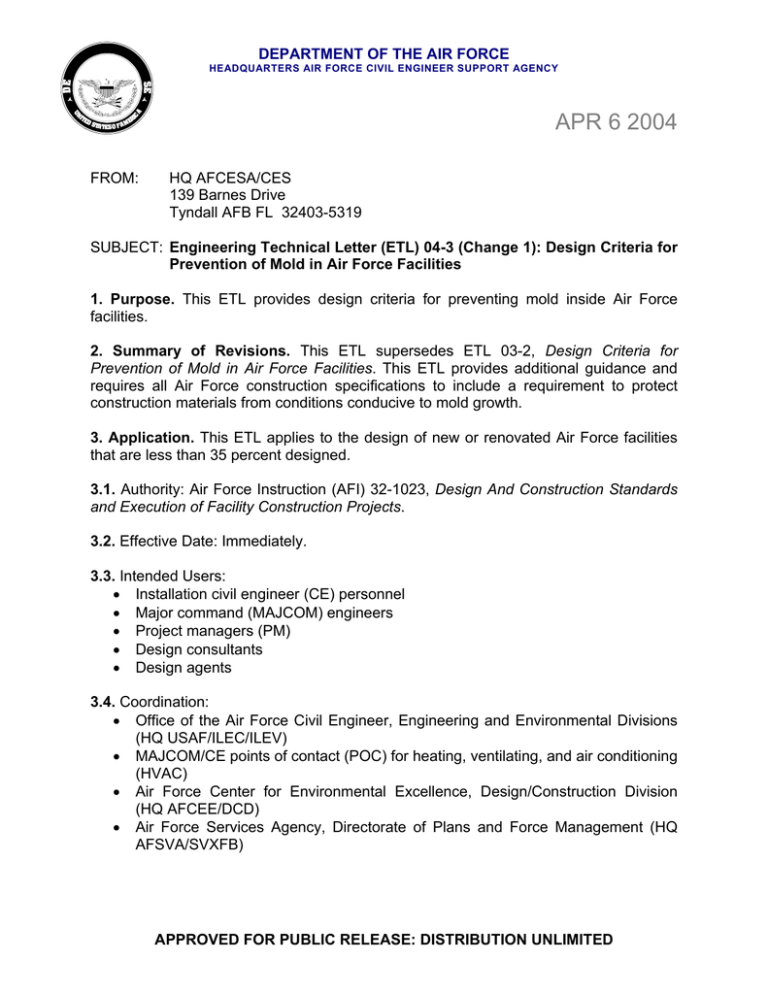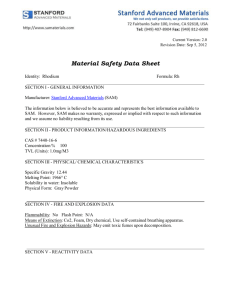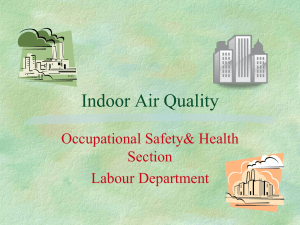APR 6 2004
advertisement

DEPARTMENT OF THE AIR FORCE HEADQUARTERS AIR FORCE CIVIL ENGINEER SUPPORT AGENCY APR 6 2004 FROM: HQ AFCESA/CES 139 Barnes Drive Tyndall AFB FL 32403-5319 SUBJECT: Engineering Technical Letter (ETL) 04-3 (Change 1): Design Criteria for Prevention of Mold in Air Force Facilities 1. Purpose. This ETL provides design criteria for preventing mold inside Air Force facilities. 2. Summary of Revisions. This ETL supersedes ETL 03-2, Design Criteria for Prevention of Mold in Air Force Facilities. This ETL provides additional guidance and requires all Air Force construction specifications to include a requirement to protect construction materials from conditions conducive to mold growth. 3. Application. This ETL applies to the design of new or renovated Air Force facilities that are less than 35 percent designed. 3.1. Authority: Air Force Instruction (AFI) 32-1023, Design And Construction Standards and Execution of Facility Construction Projects. 3.2. Effective Date: Immediately. 3.3. Intended Users: • Installation civil engineer (CE) personnel • Major command (MAJCOM) engineers • Project managers (PM) • Design consultants • Design agents 3.4. Coordination: • Office of the Air Force Civil Engineer, Engineering and Environmental Divisions (HQ USAF/ILEC/ILEV) • MAJCOM/CE points of contact (POC) for heating, ventilating, and air conditioning (HVAC) • Air Force Center for Environmental Excellence, Design/Construction Division (HQ AFCEE/DCD) • Air Force Services Agency, Directorate of Plans and Force Management (HQ AFSVA/SVXFB) APPROVED FOR PUBLIC RELEASE: DISTRIBUTION UNLIMITED 3.5. Waivers. Specific criteria set forth in this ETL may be waved at the MAJCOM level after full consideration of site conditions, life cycle costs, and the risk associated with noncompliance. 4. Referenced Publications: 4.1. Air Force: • AFI 32-1023, Design and Construction Standards and Execution of Facility Construction Projects, http://www.e-publishing.af.mil/ • Air Force Enlisted Dormitory Design Guide, http://www.afcee.brooks.af.mil/dc/DCD/arch/enlisteddormitories/index.html • Temporary Lodging Facilities Design Guide, http://www.afcee.brooks.af.mil/dc/dcd/arch/tlfdg/tlf/index.html 4.2. Unified Facilities Criteria (UFC): • UFC 3-400-02, Design: Engineering Weather Data, http://65.204.17.188//report/doc_ufc.html • UFC 4-724-01, Air Force Visiting Quarters Facility Design Guide, http://65.204.17.188//report/doc_ufc.html 4.3. Unified Facilities Guide Specifications (UFGS): • UFGS 02621A, Foundation Drainage System, http://www.ccb.org/ufgs/ufgs.htm • UFGS 15080A, Thermal Insulation for Mechanical Systems, http://www.ccb.org/ufgs/ufgs.htm • UFGS 15995A, Commissioning of HVAC Systems, http://www.ccb.org/ufgs/ufgs.htm 4.4. American Society of Heating, Refrigeration and Air Conditioning Engineers (ASHRAE): • ASHRAE 52.2-1999, Method of Testing General Ventilation Air-Cleaning Devices for Removal Efficiency by Particle Size • ANSI/ASHRAE 55-1992, Thermal Environmental Conditions for Human Occupancy and addendum ANSI/ASHRAE 55a-1995 • ASHRAE 62-2001, Ventilation for Acceptable Indoor Air Quality • 2001 ASHRAE Handbook - Fundamentals 4.5. Other Industry: • National Roofing Contractors Association (NRCA) Roofing and Waterproofing Manual (fifth edition) • International Code Council (ICC) International Building Code 2000 (IBC) 5. Acronyms: AFI ANSI ASHRAE - Air Force Instruction - American National Standards Institute - American Society of Heating, Refrigeration and Air Conditioning Engineers C CE CFM ETL F HQ AFCEE/DCD HQ AFSVA/SVXFB HQ USAF/ILEC/ILEV HVAC IBC ICC MAJCOM MERV NRCA PM POC UFC UFGS VAV - Celsius - civil engineer - cubic feet per minute - Engineering Technical Letter - Fahrenheit - Air Force Center for Environmental Excellence, Design/Construction Division - Air Force Services Agency, Directorate of Plans and Force Management - Office of the Air Force Civil Engineer, Engineering and Environmental Divisions - heating, ventilating, and air conditioning - International Building Code - International Code Council - major command - Minimum Efficiency Reporting Value - National Roofing Contractors Association - project manager - point of contact - Unified Facilities Criteria - Unified Facilities Guide Specification - variable air volume 6. Definitions: 6.1. Latent Cooling Load: The portion of the cooling load attributed to a change in the humidity ratio at a constant dry bulb temperature. 6.2. Sensible Cooling Load: Heat gain that causes a change in dry bulb temperature at a constant humidity ratio. 6.3. Humidity Ratio: The ratio of the mass of water vapor to the mass of dry air contained in a given moist air sample. 7. Requirements. 7.1. Introduction. Air Force facilities are experiencing damage from mold growth as a result of inadequate design measures to limit moisture intrusion and condensation. Though often associated with hot and humid climates, mold growth can occur wherever adequate moisture and usable food sources exist. Because many modern building products are made from materials that can provide the food source for mold, prevention of moisture accumulation is critical to the prevention of mold growth. Facility designers must provide tight building envelopes and HVAC systems that actively control space temperature and humidity levels. Contractors must also insure that building materials are protected during construction, building envelopes are sealed, and HVAC systems perform as designed. 7.2. Building Envelopes. For new construction or renovation involving roofs and/or exterior walls, design and construction at all Air Force locations must comply with the following: 7.2.1. Seal all openings around doors and windows, lintels, utility penetrations, seams in vapor retarders and air barriers, intersections of walls, roofs, floors, and foundation walls. Install non-permeable sill gaskets between floors and the bottom plate of exterior walls. Flash all windows and exterior doors with corrosion-resistant flashing to prevent water intrusion into the wall cavity. Provide design details in design drawings for these requirements. Provide details to minimize thermal bridging, especially at door and window frames and the intersections of walls and roofs. 7.2.2. Design the building envelope to control the movement of moisture and air with the effective use of water vapor retarders and air infiltration barriers. Design envelope sections to preclude condensation on interior surfaces or within wall/roof sections that would support mold growth. 7.2.3. Include in the design analysis dew point analyses for exterior walls and roof sections, showing condensation boundaries in accordance with procedures described in the American Society of Heating, Refrigeration and Air Conditioning Engineers (ASHRAE) 2001 ASHRAE Handbook - Fundamentals, Chapter 23, or equivalent. The analyses will be performed at specified space temperature and humidity levels at the following design weather conditions: 1) 99 percent dry bulb, and 2) 1 percent humidity ratio and corresponding mean coincident dry bulb. Obtain site weather data from UFC 3-400-02. 7.2.4. In locations where the wet bulb temperature is equal to or greater than 19 °C (67 °F) for more than 3,000 hours per year, the building envelope design and construction must: 7.2.4.1. Place the least permeable material or vapor retarder on the exterior side of the building insulation and place more permeable materials inside the building insulation. For double-wythe walls, place the vapor retarder on the exterior side of the inner wythe. Provide drainage from the vapor retarder to the exterior (i.e., weep holes at the base of the brick veneer). 7.2.4.2. Provide roof/ceiling/insulation systems complying with the following principles: 7.2.4.2.1. Install air/vapor retarder in accordance with guidance in the NCRA Roofing and Waterproofing Manual (fifth edition). 7.2.4.2.2. Ventilate spaces created outside the roof/ceiling vapor retarder. For sloped roofs, ventilation must comply with the International Building Code 2000 (IBC), Section 1202.2. Ensure that moisture transfer from ventilated attics into the building is minimized the same as for walls. 7.2.4.3. Prohibit entry of outside air into all spaces inside the thermal envelope. Ventilation of such spaces, if required, must use air from conditioned spaces. 7.2.4.4. On exterior walls, use only interior wall finishes that allow water vapor within the wall to escape into the conditioned space. Vinyl wall coverings, oil-based paint, and other vapor-resistant materials will not be used as interior finishes for exterior walls. 7.3. HVAC Systems. 7.3.1. Space Temperature and Humidity. Systems will be designed and sized to maintain space temperature and humidity requirements at the following ambient load conditions: 7.3.1.1. Maintain required space dry bulb temperature set point and 50 percent or less relative humidity at ambient weather design condition of 1 percent dry bulb temperature and the corresponding mean coincident wet bulb temperature. Note: Ambient design conditions for spaces with specialized technical requirements should be based on 0.4 percent dry bulb temperature and the corresponding mean coincident wet bulb temperature. 7.3.1.2. Maintain required space dry bulb temperature set point and 60 percent or less relative humidity at ambient weather design conditions of 1 percent humidity ratio and the corresponding mean coincident dry bulb temperature. 7.3.1.3. Maintain required space dry bulb temperature set point at ambient weather design condition of 99 percent dry bulb temperature. 7.3.2. Design Analysis. The HVAC design analysis for new facilities or renovation of existing facilities must include a psychrometric analysis documenting that the system meets design criteria. The analysis must provide calculations of system cooling load, energy/mass transfer through conditioning equipment and fans, and a system schematic indicating state point dry bulb and wet bulb temperatures (or humidity ratios) of outside air, mixed air, supply air, and return air flow streams. The cooling load for this analysis must be based on the load conditions identified in paragraph 7.3.1. 7.3.3. Ventilation Air. Supply ventilation air to satisfy ASHRAE 62-2001, Ventilation for Acceptable Indoor Air Quality, for the number of occupants, or as required to meet the continuous exhaust air requirement (excludes intermittent exhaust) plus 15 percent for pressurization, whichever is larger. Ventilation air must be 110 to 120 percent of exhaust air for all spaces with direct mechanical exhaust. Systems will be equipped to separately dehumidify and precondition ventilation air if the latent cooling load at the 1 percent humidity ratio and corresponding coincident mean dry bulb design weather condition causes a system reheat requirement to maintain space conditions. Systems must provide the capability to condition ventilation air and maintain space relative humidity less than 60 percent over the full range of cooling loads. Ventilation for military family housing is normally satisfied by infiltration or natural ventilation. 7.3.4. Filtering. Filter ventilation air before it enters an air handler, heat recovery equipment, or preconditioning equipment. Use extended media filters with a Minimum Efficiency Reporting Value (MERV) of 7 or greater, in accordance with ASHRAE 52.21999, Method of Testing General Ventilation Air-Cleaning Devices for Removal Efficiency by Particle Size. 7.3.5. HVAC Equipment Selection. 7.3.5.1. To ensure maintainability, select and locate equipment to provide adequate access for servicing, filter replacements, and coil removal. 7.3.5.2. To preclude moisture carryover, coil face velocities must not exceed 167.6 meters per minute (550 feet per minute). 7.3.5.3. Specify in construction bid documents cooling coil characteristics and performance requirements. These are to include total cooling capacity, sensible capacity, coil design entering and leaving air conditions (wet and dry bulb temperatures), design airflow rate, face velocities, coil sensible heat ratio, and entering chill water temperature. 7.3.5.4. Select equipment with a cooling capacity closest to the design load (no safety factors) meeting the conditions of paragraph 7.3.1. Oversizing cooling equipment inhibits dehumidification capability. (Heating equipment capacity should include appropriate safety factors.) 7.3.5.5. Several options for equipment types are available to accomplish dehumidification. Select equipment that will meet the design requirements and provide the lowest life cycle cost and energy consumption. 7.3.6. HVAC System Layout. 7.3.6.1. To the maximum extent possible, chilled water piping must be routed through pipe chases and hallways. Avoid concealing piping in the walls or ceilings of occupied spaces. Provide access for maintenance. 7.3.6.2. Insulate piping with an operating temperature below dewpoint with jacketed insulation meeting the cold piping requirements of UFGS 15080A, Thermal Insulation for Mechanical Systems. The insulation jacket must be sealed to provide an exterior vapor barrier. 7.3.6.3. Sufficiently sized, safe access must be provided for the maintenance of valves, variable air volume (VAV) boxes, dampers, controls, and other HVAC components. 7.3.6.4. Ductwork must not be installed within or beneath slab-on-grade floors. 7.3.7. Equipment Compliance. Construction specifications will require HVAC equipment submittals documenting that proposed equipment is in compliance with the design. 7.4. Dormitories, Visitor Quarters, and Temporary Lodging Facilities. 7.4.1. Ventilation Systems. In addition to meeting the requirements in paragraph 7.3, new facilities must employ separate, dedicated, central ventilation air constant-volume supply systems that supply dehumidified and tempered 100 percent outside air to all occupied spaces. The design intent of these systems is not to provide total space heating and cooling; systems must continuously condition and deliver ventilation air to each occupied space. The ventilation air must be tempered to within room comfort conditions. Ventilation air room supply conditions must not be at or below room dewpoint. Humidification of ventilation air during periods of low ambient humidity is not required. Facility central ventilation air supply systems must not be subject to intermediate season (no-heat/no-cool) shutdown. (Individual room heating/cooling equipment must have occupant control, but may be subject to intermediate season heating/cooling curtailment as directed by local command.) Systems must be designed to minimize the transmission of sound between quarters. The designer will perform a psychrometric analysis documenting that the system is designed to maintain space humidity with ambient condition of ventilation air at the 1 percent humidity ratio design weather condition. The system must provide the capability to condition ventilation air and maintain space relative humidity less than 60 percent over the full range of cooling loads. Use only metal ductwork for the central ventilation systems. Duct insulation must be external, and duct board or internal duct liner are not allowed. Note: Conditioning of ventilation air is not required for facilities not otherwise airconditioned. 7.4.1.1. Exhaust Systems. A central ducted bathroom exhaust system will be used instead of individual exhaust fans for each space. The exhaust system must run continuously and be interlocked with the building supply air system. The exhaust duct for each space must have a manual volume damper accessible from the space for proper balancing. Install an exhaust grille constructed of corrosion-resistant material just outside each shower stall and bathtub. Exhaust systems must be designed to minimize the transmission of sound between quarters. Exhaust from moisture-producing equipment (i.e., clothes dryers) must be vented to the exterior. 7.4.1.2. Heat Recovery. Use heat recovery from exhaust air to reduce the energy consumption necessary to condition ventilation air where savings from heat recovery results in a life cycle cost payback for the heat recovery equipment. 7.4.1.3. Economizer Cycle. Economizer cycle will not be used in Air Force construction. 7.4.2. Storage Spaces. Closets and storage or utility rooms smaller than 4.64 square meters (50 square feet) of floor space within conditioned spaces must have undercut doors allowing airflow through these spaces. Closets and storage or utility spaces larger than 4.64 square meters of floor space must be supplied with conditioned air. 7.4.3. Existing Facilities. Existing facilities being renovated must incorporate ventilation air supply systems as described for new facilities in paragraph 7.4.1. Where the facility structure (i.e., floor-to-floor height) prohibits dedicated central ventilation air systems, alternative package unit designs must have separate, dedicated, and continuous conditioning of ventilation air. The designer will perform a psychrometric analysis documenting that the system is designed to maintain space humidity with entering ventilation air at the 1 percent humidity ratio design weather condition. The system must provide the capability to condition ventilation air and maintain space relative humidity over the full range of cooling load. 7.4.4. Space Requirement. The design must provide sufficient floor-to-floor height, vertical distribution space, and mechanical equipment space to accommodate a ducted system to supply preconditioned ventilation air. In these types of facilities, do not use the space above the ceiling as an HVAC plenum. 7.4.5. Substrate Composition. Within bathrooms, the substrate beneath ceramic tile, plastic tile, or plastic finished wall panels in areas exposed to water (e.g., tub and shower enclosures) must be made of cement, fiber cement, or composite materials manufactured specifically for use in high-moisture locations. 7.5. Protection of Construction Materials. Construction specifications for all Air Force projects shall require all materials to be protected from moisture and conditions that have potential to result in deterioration of material properties or in mold growth during site storage and construction. Protective measures shall be taken to ensure that the construction process adequately shelters the materials to prevent mold growth and material degradation during construction. 7.6. Site Drainage. Grade/slope building sites to drain away from buildings. Provide foundation drainage systems in accordance with Unified Facilities Guide Specification (UFGS) 02621A, Foundation Drainage System. 8. Commissioning. HVAC systems will be commissioned in accordance with UFGS 15995, Commissioning of HVAC Systems, to verify and document that actual performance of the systems has met design requirements. 9. POC. Recommendations for improvements to this ETL are encouraged and should be furnished to: HQ AFCESA/CESM, 139 Barnes Dr., Suite 1, Tyndall AFB FL, 324035319, Attention: Mr. K. Quinn Hart, DSN 523-6343, commercial (850) 283-6343, FAX DSN: 523-6219, E-mail quinn.hart@tyndall.af.mil. JEFFREY L. LEPTRONE, Colonel, USAF Director of Technical Support 1 Atch 1. Distribution List DISTRIBUTION LIST DEPARTMENT OF DEFENSE AAFES ATTN: RE-C PO Box 660202 Dallas, TX 75266-0202 Defense Commissary Agency (1) Design and Construction Division 2250 Foulois St., Suite 2 Lackland AFB, TX 78236 (1) SPECIAL INTEREST ORGANIZATIONS Information Handling Services 15 Inverness Way East Englewood, CO 80150 (1) Construction Criteria Base (1) National Institute of Bldg Sciences 1201 L Street NW, Suite 400 Washington, DC 20005 Atch 1 (1 of 1)





